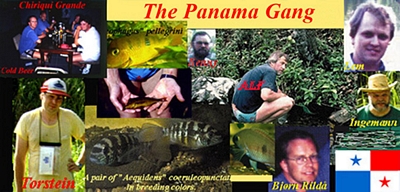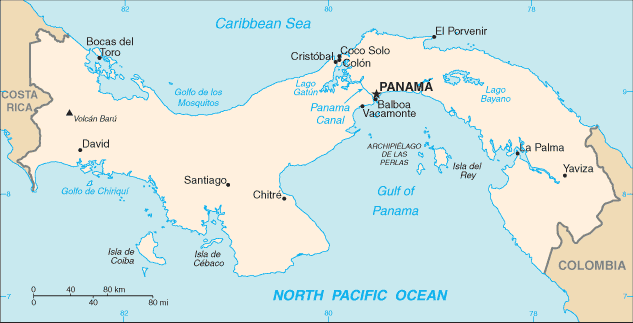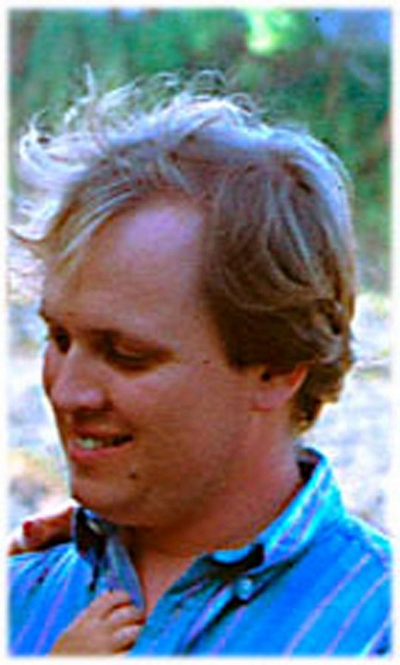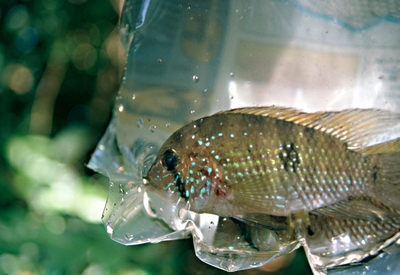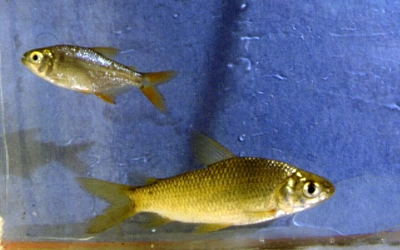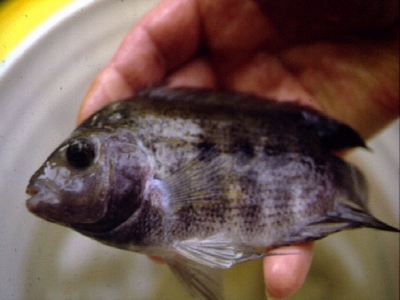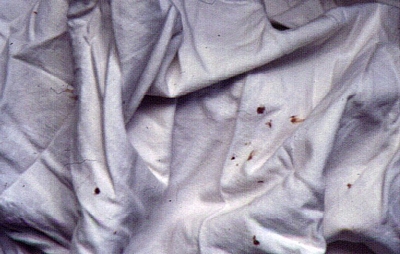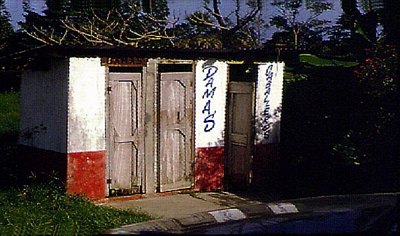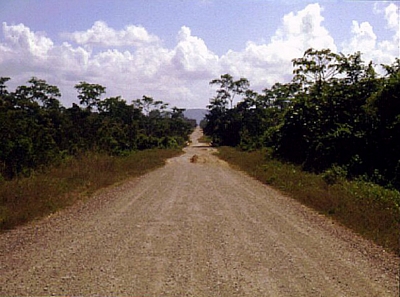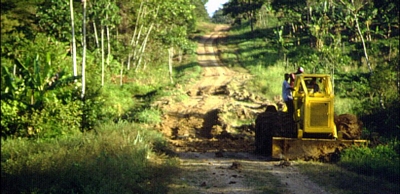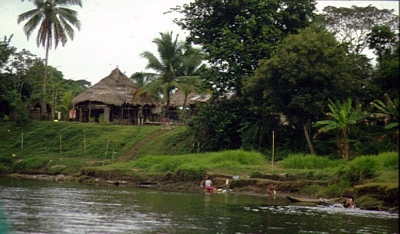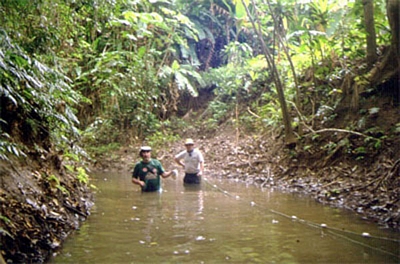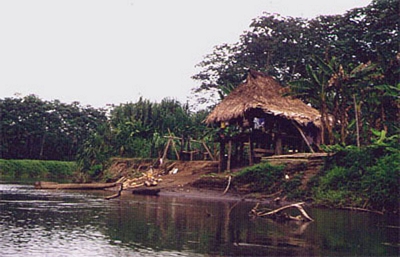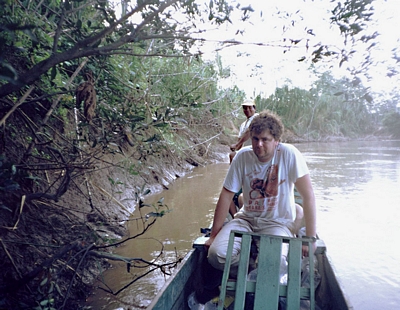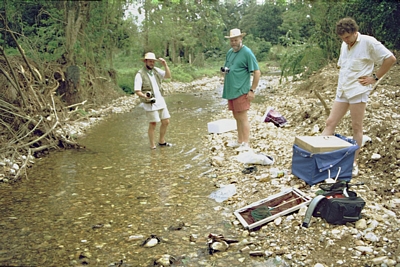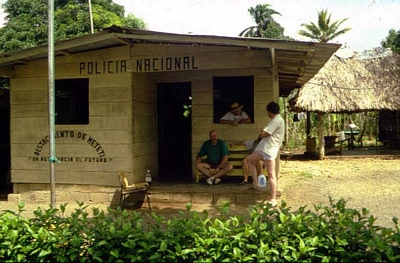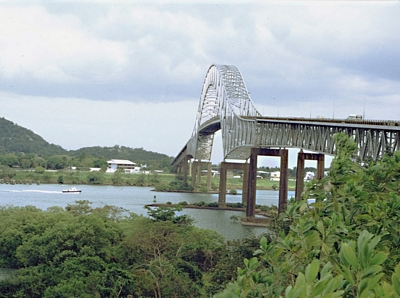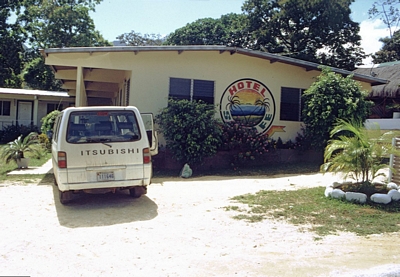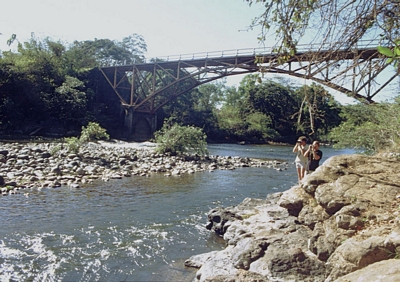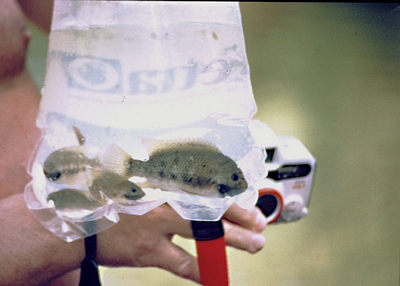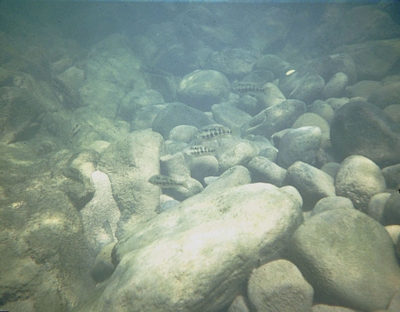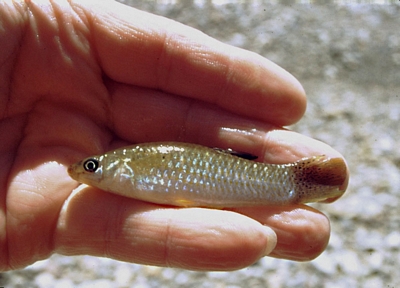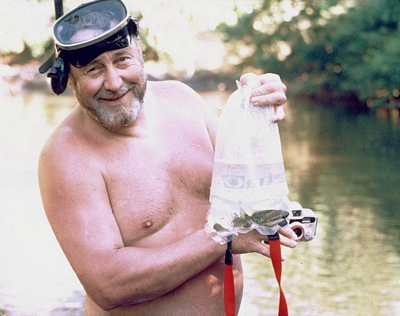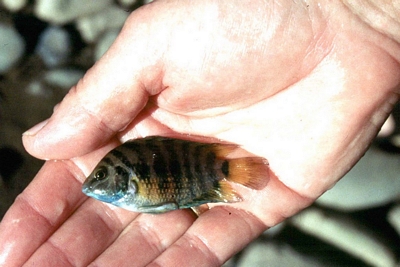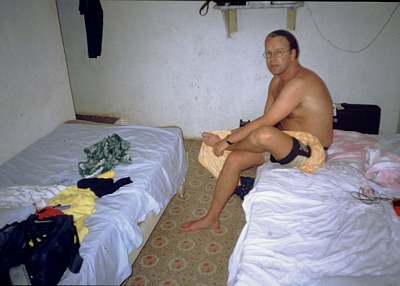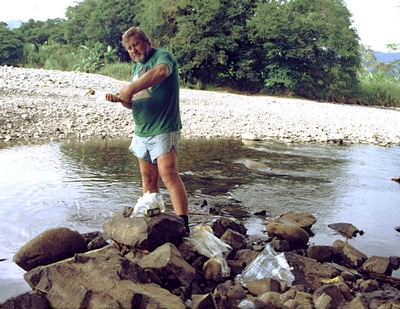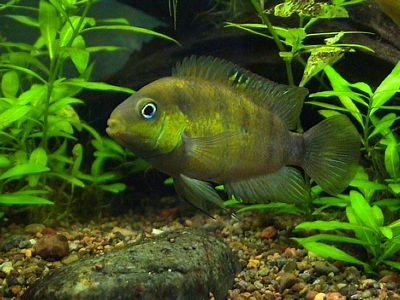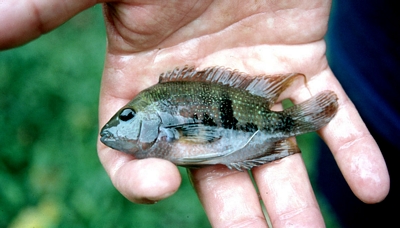Collecting in PanamaCLICK ON ANY IMAGE TO ENLARGE IT Well, I will tell you a little from my trips to Panama. Panama is a nice country to travel in and does also have some nice fish. Maybe not so many as other countries have, but still it does have some. This time we flew to Panama in February, on a little different route because it was a little cheaper. But, longer too, I think it took about 26 hours for the trip to Panama City. Well, aquarist can take that when they know what's ahead. I had booked two rooms at the Hotel Acapulco. Not the biggest Hotel and rather ordinary, but the restaurant downstairs is extraordinary. The food there is very, very good, and the staff is very nice and the cold beer tastes very good too. We were only three, my wife, my good friend Ingemann Hansen and myself in the beginning. My good friend Tor Kreutzman from Finland should come about a week later. My good friend Ariel R. Padilla from Panama wanted to come along, but could not come for as long as he wanted. There was something to do with his work that prevented him. But he was with us when we collected 'Geophagus' crassilabris.
South and Central American countries are wonderful to visit and for me they have the most interesting cichlids too. So, this time I will tell you about the trips to Panama in 1996 and 2001. We started in Panama City where we were met by a friend that I met on the internet, namely Lemuel E. Bryant.
He is rather new to the hobby, but is eager to learn, and I think he picked up a thing or two when he was with us the first week. We used a couple of days around Panama City to make everything ready to go down to Yaviza, but we did collect fish there too. We had to change the car to a jeep, because we have heard that close to Yaviza the road was gone, due to heavy rain. And the road was in really bad shape for the last 20 km. In the beginning, out from Panama City, we went south (?) or east (?). Anyhow, we were driving toward the Colombian border. You can choose if you will call it east or south. I'll call it south. We did not go too far before we came to a river we thought looked interesting, this was about 26 km from the new highway and the name on the river I think was Rio Tranca? There we collected different Tetras, Hoplias and "Aequidens" coeruleopunctatus. The position was 09°08'20"N and 79°12'34"W. The temperature in the river was 26.1°C. pH 8.2 - dH 5 and microsiemens was 120.
The next river was Rio Espave, again I think, because the map I had was not too detailed. But the position should be ok. It was 09°09'01"N and 79°10'46"W. There we collected Ancistrus chagresi, "Ae." coeruleopunctatus, a Redfin Tetra, and a Characidium sp. In the afternoon we came to a river called Rio Chichebre? The water temperature 72°F or about 22.2°C. The pH was 7.9-8, dH 5, kH 6 and the microsiemens was 190. The position was 09°09'41"N and 79°09'13"W.
Among the Redfin Tetras, Curimata sp and "Ae" coeruleopunctatus we also collected a cichlid we think was "Cichlasoma" tuyerence (see photo).
We made camp on the shore of the river. Maybe not the best place because of all the rocks, but we had a good night. We only had to take cover under the plastic, because of a heavy rain shower. But this place did not have so many mosquitos. We did dive in the night with flashlights, and some of the fish, especially the large cichlids were easier to catch then. We did collect in several places as we moved south, but the rivers had much the same fish. It was not until we came to a river we think again, was Rio Nicanor. There we collected "Geophagus" pellegrini. I had only collected the fish in Colombia, in the Choco. This was all right then I know, that the fish has a wider distribution than expected in the beginning. We did also collect Rineloricaria sp, "Cichlasoma" sp, "Ae" coeruleopunctatus, Astyanax sp, Characidium sp, 2-3 types of livebearers and a very special Ancistrus sp. The air temperature was 33.5°C, pH 7.8, dH 6, kH 6 and microsiemens was 200. The position was 08°33'24"N and 78°01'18"W. Then we stopped at other places and in the afternoon we had to look for a place to make camp. The place we found looked very good, but became my worst night I ever had, sleeping outdoors. I've been freezing, I've been wet, but this ... Lem slept in a small tent he had brought with him, Ingemann and Benny had their mosquito net, Torstein slept in our car and I had only a sheet as cover for the night. With the twilight, the mosquitos came. Not a couple or a few, no, they came in a massive attack, all night long. Well I shall spare you the details, but my sheet looks like I had taken a shot at the sheet with a shotgun loaded with ketchup.
Just before we finished our trip in Panama, I got fever, maybe malaria (?). So after a bad night, I was very glad to get up at dawn, and we did not make any breakfast at that place, we just packed our things and started driving. After a couple of hours driving we came to a small place which had a small restaurant, and we had our breakfast there.
After breakfast we hit the road again. The road was a dirt road, but still acceptable. But not every story has a happy ending; how long was Adam in Paradise? Between 15-20 km from Yaviza it was the end of the "good" road. After that we had to drive outside the road several times. Others had done it before us, we just followed the tracks.
Then we came to a mudhole, where we went out of the car to take a look. Somebody had been driving through, so I was to go first. I did not get very far before I was stuck in the mud. The central part between the tracks was high so the wheels could not get any grip, the wheel were only spinning. But, we managed to get the car back on dry land with the car in reverse and pulling with all four wheels. So we thought, this was the end of it, we would not reach Yaviza and had to stay another night outdoors. We were not so keen on staying outdoors one more night after the nightmare with the mosquitos last night. And we were dreaming about a good meal and cold beer. Then somebody must have heard our prayer. On the road on the other side of these mudholes a tractor with a blade in the front came, and Lem went down to talk to the driver. We made a deal with him, to scrape some of the mud in the central part of the tracks away, we gave him $10, one beer and a couple of Cokes.
Then Lem went over with his car first and I came after, and we both made it. We asked the driver how the rest of the road to Yaviza was, were there any big holes like this? No, no the driver said, it's better(?). If we had known how the rest of the road was, we would probably have turned around, but as a carrot to go along, we were thinking about the mosquitos last night and cold beers in Yaviza. We drove just up the hill and on the other side there were new mudholes. This hole was very wet, so I took a stick to measure the depth. I found out that the track felt firm in the holes and told Lem I was going to try to drive stright through. I put the car in low gear and full speed and managed to get through. Lem followed, and so we took hole after hole. In one place they had placed logs outside the road to drive on, the logs were very narrow and slippery, and Lem suggest to try on the other side. I said no way, we would just end up in the ditch. So we went for the logs and managed to get over. In one hole Lem was stuck with his car, but we managed to give him a push and he came out of the mud. And suddenly we were in Yaviza. Hurray, hurray, we made it. We stopped a guy and asked him where we could find our hotel, the "Tres Americas". We found it, and the "Boss" had a room for us, and would charge us US$25 for the night. We accepted it and drove the cars to the back of the "Hotel".
Well, hotel? This place would never have been called a hotel at home. But out here in Yaviza it was the only possibility to get a roof above your head, or we had to sleep outdoors again. So we took it. It had only four beds, so Lem said he could sleep on the floor on his airmattress. I was very lucky with my bed, not that it was any better to sleep in, but my bed did not have an anthill in the mattress. Small ants, but still ... We did not see the ants before the morning because it was dark when we went to bed, after a hot meal and some few ... cold beers. So who suspect ants in the bed? Ingemann said in the morning, "Something has been feeding on me through the night", and then we discover the ants. Nothing serious, but who likes to sleep with ants in the bed! I asked the owner in the morning about hiring a canoe. He said he knew one that could take us up in the rivers, it would coast us US$45 + gas per day. So even though we thought it was expensive, the cost was split five ways, so we took it. We used some of Lem's extra gas, because his jeep was running on gas, but my car was running on diesel. We found out that the owner of the hotel had to be some sort of Mafia Boss in the town, because he had the only "hotel"! He had the restaurant, he had a shop, he was running videofilms on a TV in the back and everyone who wanted to look had to pay an entrance fee. He also arranged cock fights in a ring at the back. And he had also a finger in the canoe business, we found that out later. The first river we went up the first day was Rio Chico, and we past a couple of Indian camps on our way upriver. When we came down again we stopped at the biggest camp named Corozal.
We visited the Chief and our driver asked if we could take photos, but he said no. I got some video from the camp, because I turned on the video camera while we were walking around in the camp. The scenes I got were not too bad. I got of course, my friend's leg and the roof on some of the huts, but some of it turned out well too. So we bought some handycrafts and went down to the canoe to go down the river to Yaviza. We did not collect much the first day, just some catfishes belonging to Chaetostoma and Ancistrus species. We reached Yaviza just after dark, and guess what tastes good in the evening? You were right ... cold beer. In the morning the day after, just after breakfast we were on our way again. But this time we went up Rio Chuqunaque and later we turned right up into Rio Tupisa. I don't remember how long we drove up in Rio Tupisa, but we found a small stream that was not so turbid, and we decided to go up the stream. The stream was narrow so we could not use the outboard motor, we had to use a pole to push the canoe upstream. We came to a bend in the stream, and the canoe was too long to pass, so we decided to try there. I took my diving mask, net and a couple of plastic bags and jumped into the water. Lem and the others guys decided to try with the net. I collected quite a few Rhineloricaria species and the others collected Hatchetfish (Gasteropelecus maculatus), 'Aequidens' coeruleopunctatus, a livebearer species, a Tetra (probably Astyanax) and a Pimelodella. The temperature on the water was 24,5°C, and this was the first place so far in Panama we had a pH under 8, it was 7.6 and the dH was 0, kH was 2 and the microsiemens was 38. The position was 8°12'02"N and 77°41'17"W.
We went out into Rio Tupisa and up to another stream a little bit larger. I think the name on this little stream was Tutumate, here I did collect Sturisoma dariense, Rhineloricaria sp, Ae. coeruleopunctatus, Hatchetfish and Astyanax. The water temperature was 28.9°C, pH 8-8.2, dH 13, kH 13 and microsiemens was 190. The position was 8°12'05"N and 77°41'03"W. On our way out of this stream we saw a little canal. Lem and Benny jumped out into this canal and tried to catch something with the dipnet, before it was getting too dark.
Next morning we were going back to Panama City, and after breakfast we paid the "Boss". He asked for payment for the canoe too. But I told him we had paid the owner of the canoe, and we were not interested in paying twice, the price was high enough. After packing all our things into our cars we hit the road back to Panama City. We were not in a hurry, so after the first 20 km, when we had passed through all the mudholes, and got through them without big problems we relaxed a little. We stopped at several streams/rivers to see what kind of fish we could find. It was about 47 km from Yaviza, at a place called Santa Rosa, that we made a longer stop.
There we had our "lunch" and we also changed water on the fish we had in our styrofoam boxes. In the river there we did collect 'Geophagus' pellegrini, Livebearers like Poecilia mexicana and Phalloceros caudimaculata, I think. Astyanax, and 'Ae' coeruleopunctatus. After lunch we were on our way again when we passed a sign saying Meteti to the left, and that road was also paved with asphalt. We continued, and suddenly a Toyota Hilux truck was blocking our road and a couple of guys came to my car. I opened the window just a little so I could hear what he wanted. I saw the other guy had a gun in his back pocket and watched him. Then the first one showed me a police badge, and said we had to follow him, I asked him where? He said to the police station. So he climbed into our car and told us to turn around. Well we did not have any choice, so we followed his instructions and drove up to the police station in Meteti.
So we were taken into custody. At the station we asked what this was all about. They said that they got a message on the radio from the police station in Yaviza to stop us. We enquired why, and they said that the owner of the hotel (The Boss) said we had left without paying the rent for the canoe. We told the officer that this was a lie, we had paid directly to the driver of the canoe. We did not know what kind of deal the Boss had with the canoe driver, and we did not care. We had paid for everything in cash, so we could not show any receipt. The police officer made contact with the local police station in Yaviza (there was no telephone down there) and told them what we had told him. We said that they should ask the Indian canoe driver, and they said the driver had said he had not got any money from us. I said that all my friends saw me paying for the canoe. So they told the local police to bring the Indian to the station for questioning. An hour later, they were back on the radio, and they told us that he had confessed that he had received the payment from us. So, the Boss was also on the radio, and told the police officer to apologise to us, so we were told that we could go. I was never afraid, as we had not done anything wrong, but you never know. So we decided to drive straight ahead to Panama City, to the Hotel Acapulco, for a nice steak and several cold beers. The trip continued, as we went north the next day. But will I leave that story to another time. I hope you enjoyed this part, and let me hear from you. See you, You can reach me by e-mail at: alf@cichlid-power.com.
Part 2:
Well, we headed north to San Carlos and passing the bridge Puentes Americas we made a stop to take some photos and then headed for Chorrera and further up to Chame. We drove out to Punta Chame to look for rooms, but there were none at the hotel out there. Before we came to Chame we stopped at a small town called Capira with a nice river and collected a nicer type of "Aequidens" coeruleopunctatus, Brachyraphis escopi(?), another livebearer, I think was a Giradinus species and there was also a Brycon tetra and a Lebiasina. Water parameters in the Capira River
After Punta Chame we went down to San Carlos where we had rooms at a small hotel. After dinner and a few(?) beers, we wrote down the dates from the river, then it was the time for bed. The day after we left San Carlos heading for Penome and passing Penome, we stopped by a river 22.5 km south from Penome. The name of the river was Rio Grande, the water was a little turbid but I managed to collect a Tomocichla sieboldi, Aequidens coeruleopunctatus, a livebearer (I think was Neoheterandia tridentiger), Brycon sp and Curimata sp. Water temperature was 25.2°C, air temperature was 29.4°C, pH 8, dK 1, kH 1 and microsiemens 50. GPS position: 8°25'25"N and 80°30'10"W. We continued further down to Las Tablas and from there to Macaracas, it was very dry there, but we found a small river just 2.5 km before the town. The name of the river was Rio Estivana, we worked there for about 2.5 hours. I collected several Sturisoma sp, 'Aequidens' coeruleopunctatus, Pimelodella sp and Brycon sp, but we did not see any livebearers. We took water samples and got a place at the Pension Lorena in Macaracas. Just down the street, we found a small restaurant. We also stopped for a while in the river the following day to catch more of the Sturisoma. Air temperature: 29.4°C. The water parameters were: temperature 26°C, pH 8.5, dH 5, kH 6, 190 mS. GPS position: 7°44'48"N and 80°31'53"W. Time 17:00. We drove to Los Pozos and Las Minas and stopped by a river called Rio Parita. We had passed this river out near the coast on our way down from Chitre and toward Las Tablas. I said that we probably would meet the river on our way inland higher up, and we did. From being a turbid river near the coast it was not bad up here. I collected 19 small Sturisomaticthys, 'Aequidens' coeruleopunctatus, some underwater photos of the fish, and there were Pimelodella sp, Gobi type, Brycon sp tetras, Curimata and probably a Pleco type. Water temperature: 26°C, air temperature was 33.7°C, pH 8.5, dh 5, kH 5 and 200 mS. I forgot to take the GPS, but since it was under the bridge, the name of the river was Rio Parita and it was between Las Minas and Ocu, so it will be easy to find again. When we were finished here we drove through Ocu and up to the main road where we turned left for Santiago. Just before Santiago, we found a hotel/motel called Nuevo Daule and we paid $29 for a double room with a bath and toilet, and also with warm water in the shower. It also has a swimming pool. After we had supper, we wrote down what we had done today. The next day we went up to San Fransico and Santa Fe to see what we could find along the road, and stay another night here. Then we drove to David and checked rivers we found with good water. Then over the mountains to Boca del Torro, on the Atlantic coast.
We drove up to San Fransico and Santa Fe. I had hoped that we could get further, but they said we could not get any further with the car we used. So we turned around to go back, but we made a stop at Hotel Santa Fe, which I did not know about, to cool down a little. From our new Hotel Plaza, which is close to the main road outside the centre of Santiago, to here it was 64.9 km. Of course we looked for fish and we made a stop at the bridge crossing Rio Gaitu.
We changed the water on our fish, before we went into the water. I collected Tomocichla sieboldi, livebearers, Sturisoma sp, 'Aequidens' coeruleopunctatus, Pimelodella, Tetra and Eleotridae. The water was rather clear, and the current was rather strong in the middle of the river, the bottom layer was mostly boulders, and among these rocks the Tomocichla sieboldi had a good time. They were not easy to catch, but I collected 5-6 Sturisoma sp. It was 31 km from the hotel up to the river. Water temperature was 25.4°C and the air temperature was 29.9°C. pH 7, dH 1, kH 1 and 50 mS. GPS position was 8°18'04"N and 81°00'32"W.
We continued further down and came to the river Santa Maria, and made a stop there. We collected livebearers, 'Aequidens' coeruleopunctatus again, Pimelodella sp, and some large Gobies, Eleotrida and Poecilia mexicana or butleri (?). Water temperature was 24.5°C, air temperature was 32.6°C, pH 7, dH 1, kH 1 and 38 mS. GPS position was 8°24'45"N and 81°03'16"W. Just before (15.4 km) Santa Fe we looked into a small stream called Quebrada El Nance. I collected five Tomocichla sieboldi, large Poecilia butleri (?), Pimelodella, 'Aequidens' coeruleopunctatus again, and as usual Brycon sp. Water temperature: 28.5°C, air 31°C, pH 8.5, dH 2, kH 3 and 70 mS. GPS: 8°24'46"N and 81°02'54"W.
Today we drove from our Hotel Plaza Grand David and did not stop before we came to Rio San Pablo. There I collected a Loricaria sp, T. sieboldi, and there were also some large Gobies, Eleotidae maybe two types, Poecilia butleri (?), Brycon sp, Curimata, Pimelodella sp and of course 'Aequidens' coerulepunctatus. Water temperature: 25.8°C, air 28.8°C, pH 7, dH 1, kH 1 and 42 mS. It was sand and rocks as bottom layer, rather clear water, but fast-flowing. GPS: 8°12'01"N and 81°15'05"W. Then we went 18 km to a river called Rio Cobre. There we did not collect much, maybe some livebearers, Gambusia. Water temperature 26.7°C, air 34°C, pH 8, dH 2, kH 2 and 70 mS. GPS: 8°13'09"N and 81°23'06"W. We drove further toward David and came to a river called Rio Chorcha. In this river we collected for the first time, Cichlasoma latifrons. Very nice fishes, but difficult to collect bigger fish, so I snatched some fry from a pair. There was also T. sieboldi, Loricaria, gobies, Brycon sp, and livebearers. Then we measured the water before we went to Hotel Fiesta, which is just outside David. This hotel was a little more expensive than the others we had stayed at, $52 for a triple room and $42 for a double room. Rio Chorcha water temperature 29.8°C, air 35.1°C, pH 7.5 , dH 2, kH 2 and 60 mS. GPS: 8°24'34"N and 82°12'51W.
Chiriqui Grande The day after we headed to Chiriqui Grande on the Atlantic side. We did not know how long this would take, we had heard different times, depending on the road conditions. We made it in three hours, but we made several stops on the road. When we started off from the Pan American Highway there was a sign saying 92 km. This was not correct, we measured it at 112 km. We looked forward to meeting the Rio Guarumo and were a little excited, because this was the first river on the Atlantic or Caribbean side, and there would be new and interesting fish. We would find 'Cichlasoma' nanoluteus, Zebra cichlids, a new "Cichlasoma" Chuco, and probably "Cichlasoma" alfari.
This fish belongs to the new genus Amatitlana, which includes four species. We thought it was a nice Zebra cichlid, but this fish is not found in Panama, but in Lake Amatitlàn, Guatemala. When we came to the Rio Guarumo, we HAD to stop by the bridge and enter the water. We grabbed our nets, plastic bags, and diving mask. I did not stay long in the water before I saw my first "C." nanoluteus and I also managed to collect two smaller ones and a small "C." alfari (?). I also collected some large Poecilia butleri, and maybe some Brachyraphis sp. Then we were satified so far and continued on to Chiriqui Grande. Now we had to look for some place to stay for the night. Hotel Fuentes should be good, we were told it should be the best in town (?). Well it's good enough for aquarists on a collecting trip who are not that fussy. One room with a small dark room they called toilet and shower without light. Two beds and a fan that stopped at 24:00. But the temperature was not too bad so we managed to sleep. Even the beds were not that good. The springs in the mattresses were not kind to your back, and you had to form your body between the springs, but this was not easy. But, for $9 per double room, maybe you could not expect more.
Today we went 13.8 km out from Chiriqui Grande to Rio Guarumo again. We changed the water on our fish and we had several bags to change, so this took some time.
After the changing of water we collected a livebearer, Alfaro cultrata, large Poecilia butleri, "C." nanoluteus, "C." alfari (?) and Brachyraphis sp, Zebra cichlids, there was also a goby type and Eleotridae. Then we took photos under and above the water and of course, water samples. Water temperature: 27.8°C, air 31.2°C, pH 7.5, dH 3, kH 3 and 70 mS. GPS 8°54'21"N and 82°11'09"W.
The next day we changed water by the bridge and then we headed for Panama City, and that is about 600 km. Well we made it to Panama City without stopping at any places to collect any fish and we booked in at Hotel Dos Mares, since they did not have any rooms available at the Acapulco. But the hotels were beside each other, and we changed to Acapulco the day after. They had a parking lot with a guard and they closed the gate at night, so the car was safe. On Saturday the 24th of February 1996. We went outside the city to find a river with clear water to change the water on our fish bags. In this river (Quebrada Custodia) we collected 'Geophagus' crassilabris, 'Aequidens' coerulepunctatus, Loricaria sp, Pimelodella sp, "Cichlasoma" panamensis, killifish and Poecilia sp. The water temperature was 26.3°C, air 36.3°C, pH 7.5, dH4, kH 4, and mS 100. GPS: 9°07'59"N and 79°35'07"W.
So the trip is over; I hope you enjoyed it.
DISCLAIMER: Statements made on this page are not herewith made available for the purpose of zoological nomenclature © Copyright 1995-2013 Alf Stalsberg – Cichlid Power |
|||||||||||||||||||||||||||||||||||||||||||||||||||||||||||||||||||||||||||||||
